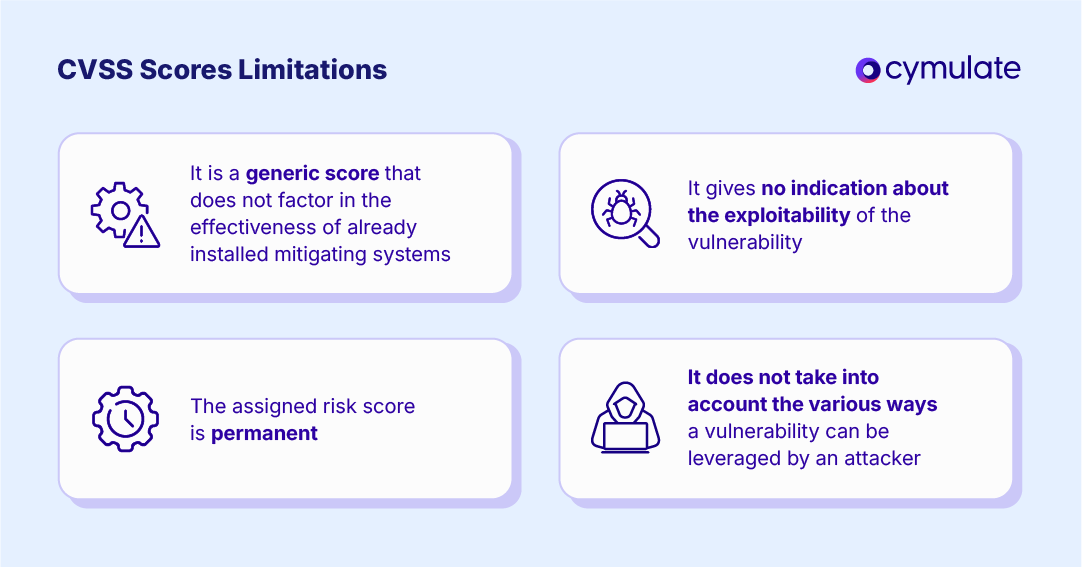Unlock Success with Risk-Based Vulnerability Management
Risk-based vulnerability management is the latest recommended approach to adapt vulnerability assessment (VA) and vulnerability management (VM) to technological and threat landscape evolution and should be at the center of vulnerability prioritization technologies (VPTs) development.
It introduces a switch in perspective from focusing on whether a system gets patched to whether the specific risk of a system vulnerability has been sufficiently mitigated. The limitations of traditional vulnerability management highlight the growing need for more contextual and data-driven vulnerability risk management practices that focus on real exploitability rather than static scores.
This post examines the logic behind that recommended switch in perspective and ways to put it in practice.
Key highlights:
- Moves beyond CVSS-only prioritization: Traditional vulnerability management often prioritizes fixes based solely on Common Vulnerability Scoring System (CVSS) severity, which doesn’t always correlate with real-world risk. RBVM factors in exploitability, asset criticality, and threat context to focus on vulnerabilities that pose the greatest actual risk, not just the highest severity score.
- Closes the risk–resource gap: RBVM helps teams avoid wasting effort on low-impact issues. This ensures limited remediation resources are spent where they deliver the most risk reduction. Instead of patching “everything critical” (which often isn’t feasible), organizations address the vulnerabilities that truly matter first.
- Enables smarter security decisions: A risk-based approach provides context-driven insights (such as whether a vulnerable system is exposed to the internet or is protected by controls) to guide strategy. Security and IT leaders can better allocate budget and time, balancing operational demands with risk reduction.
- Continuous validation with Cymulate: Cymulate operationalizes RBVM by continuously testing and contextualizing vulnerabilities. It integrates Breach and Attack Simulation, Contiuous Automated Red and Exposure Analytics to validate security controls in real time, prioritize exploitable weaknesses, and automatically focus remediation based on business impact.
What is risk-based vulnerability management (RBVM)?
Risk-based vulnerability management (RBVM) is an approach to vulnerability management that identifies and prioritizes vulnerabilities based on the risk they pose to the organization. Rather than treating all high-severity vulnerabilities as top priority, RBVM considers contextual factors like threat likelihood, exploit availability, and asset value.
Risk-based vulnerability management involves identifying and prioritizing the most critical vulnerabilities that pose the highest level of risk to a business. By focusing on these vulnerabilities, organizations can allocate resources more effectively and address the most pressing security concerns. This approach allows security teams to proactively mitigate risks and enhance their overall security posture.
Through the use of threat intelligence and data-backed security decisions, organizations can ensure they are targeting the vulnerabilities that have the most significant impact on their business operations, thus focusing on the likelihood of a vulnerability being exploited.
Practically, that means evaluating the vulnerability threat severity based on its exploitability in context. When compensating controls are reducing or eliminating the possibility of actually exploiting a vulnerability, it can remove the urgency of remediating CVSS with a high vulnerability severity score.
Conversely, a lower-scored CVE with a higher exploitability risk and vulnerability risk should be pushed higher in the prioritization schedule, streamlining remediation efforts.
Read more about cybersecurity scoring.
Why traditional vulnerability management falls short
Traditional vulnerability management, which often relies on periodic scanning and prioritization based primarily on severity (e.g. CVSS scores), struggles to keep up with today’s threat environment. This approach often overlooks vulnerability management risks, such as failing to account for exploit likelihood, business impact, or compensating controls that change the actual level of exposure.
Limitations of CVSS scores
The Common Vulnerability Scoring System (CVSS) is the most widely used method for rating the severity of software vulnerabilities. Maintained by FIRST (Forum of Incident Response and Security Teams), CVSS assigns each vulnerability a score from 0 to 10, where 10 represents the most severe.
Prioritizing patching schedules has traditionally focused on patching vulnerabilities with a high CVSS score first. Yet, a high CVSS score does not necessarily point to a high probability of exploitation. Sometimes, they are even downright inaccurate, as, for example, the CVE-2020-19909 that was published with a 9.8 severity score long after the issue had been fixed.
However, relying mainly on CVSS scores can leave organizations vulnerable to software vulnerabilities that may not have a high score but are still exploitable, highlighting the importance of considering the overall risk level of a vulnerability.

In short, focusing primarily on severity scores might cause defenders to invest their too scarce time for little benefit. Remediation processes are unfortunately not instantaneous.
To tackle this issue, Gartner and other thought leaders are now advocating the adoption of what they call risk-based vulnerability management (RBVM).
Vulnerability overload and lack of context
The sheer volume of vulnerabilities confronting organizations today makes a purely severity-based, “patch-everything” strategy untenable. The number of new vulnerabilities disclosed each year has been rising sharply, reaching record levels.
No security team can realistically remediate tens of thousands of issues annually. Traditional vulnerability management tools often dump massive lists of vulnerabilities on teams with no insight into which ones to fix first.
This leads to analysis paralysis and alert fatigue: teams waste time chasing findings that aren’t likely to ever be exploited, while truly critical holes may be lost in the noise.
Compounding this is the lack of context in legacy approaches. A vulnerability scan might tell you a server has 100 “high” findings, but not which of those are exposed to the internet, which have known exploits, or which affect systems that, if breached, could cripple the business.
Traditional VM tends to provide static, point-in-time snapshots of vulnerability data without correlating to real-world threat activity. It’s also typically reactive, find a vulnerability, then fix it, which struggles to keep pace with threats that evolve daily.
Attackers increasingly exploit new vulnerabilities within days (sometimes minutes) of disclosure, and they often chain together multiple low-level weaknesses to achieve a breach. A narrow focus on individual CVSS scores misses these dynamics.
Key differences between risk-based vulnerability management and traditional vulnerability management
| Traditional VM | RBVM |
| Severity-driven, CVSS first | Risk-driven, exploitability and context first |
| Focused on patching everything critical | Focused on reducing actual risk |
| Point-in-time scans | Continuous assessment and validation |
| Measures patch counts and compliance | Measures risk reduction and resilience |
Embracing a Risk-Based Vulnerability Management (RBVM) approach marks a crucial shift in how security and IT teams address vulnerabilities within an organization.
Prioritization philosophy
Traditional vulnerability management is severity-driven. It follows CVSS scores as the main signal, patch all “critical” and “high” findings first. The issue is that severity doesn’t always equal risk.
A 9.8 CVSS bug on an isolated system with strong controls may be less urgent than a 6.5 vulnerability actively exploited on an internet-facing asset. RBVM flips the model by asking: which vulnerabilities pose the highest risk to our business right now?
Context and decision-making
Legacy programs generate long lists of vulnerabilities but offer little context. Teams are left with overwhelming data and no clear path forward.
RBVM enriches findings with threat intelligence, exploit data and business asset criticality. The result is a ranked queue of vulnerabilities that can be mapped to risk-based SLAs, ensuring resources target the most pressing exposures.
Operational scope
Traditional approaches were built around on-premises infrastructure, servers, desktops and a static perimeter.
Modern enterprises run workloads across cloud, containers, SaaS, and remote endpoints. RBVM accounts for this expanded attack surface, ensuring visibility and prioritization extend across hybrid environments.
Outcomes and measurement
Success in traditional programs is often measured by patch counts or compliance checklists. RBVM focuses on risk reduction, metrics such as mean time to remediate critical-risk exposures, coverage of known exploited vulnerabilities, or downward trends in organizational risk scores. This makes outcomes more meaningful to both security teams and business leaders.
Components of a risk-based vulnerability management framework
Successfully implementing RBVM in an organization requires several key components and capabilities. These form the foundation of a risk-based vulnerability management framework:
Comprehensive asset discovery and inventory
You cannot manage or protect what you can’t see. A robust RBVM program starts with identifying all assets across on-premises, cloud, and remote environments. This includes traditional IT assets as well as cloud instances, containers, IoT/OT devices, and external-facing systems.
Maintaining an up-to-date asset inventory ensures that no vulnerable system flies under the radar. Automated discovery tools and integrations (with cloud platforms, container orchestration, etc.) are often used to achieve full visibility.
Contextual risk assessment
Once assets and vulnerabilities are identified, each vulnerability should be evaluated in context. This means correlating vulnerability data with threat intelligence (Is there known exploit code or active attacks for this vulnerability?), asset criticality (What is the business impact if this system is compromised?) and environmental factors (Is the system exposed to the internet? Are there compensating controls in place?).
This risk assessment stage essentially transforms a raw vulnerability scan into actionable risk insights. Many organizations adopt scoring models or formulas to quantify risk (e.g. assigning higher risk to vulnerabilities that are both exploitable and on critical systems).
Risk-Based Vulnerability Prioritization and Remediation Planning
With a risk score or categorization assigned to each vulnerability, the next component is a structured prioritization process. Rather than a flat list of “critical/high/medium” based on severity, the outcome is a ranked list of remediation tasks based on risk.
Typically, clear SLA timeframes are established according to risk level – for example, a critical risk vulnerability might be addressed within 48-72 hours, whereas a moderate risk can be fixed in the next monthly cycle.
Planning also involves deciding the appropriate remediation or mitigation: in some cases a full patch is needed immediately; in others, risk might be mitigated by adjusting a firewall rule or disabling a vulnerable service until a patch can be applied.
Remediation and mitigation execution
This is the hands-on component where fixes are deployed. A risk-based framework often leverages automation and integration to streamline this step. For example, integration with ticketing systems can automatically create tickets for high-risk vulnerabilities, and configuration management tools can be triggered to apply patches or changes for known issues.
Mitigation can also involve applying temporary controls (like isolating a server or implementing a virtual patch in a web application firewall) until permanent fixes are in place.
Validation and continuous improvement
After remediation, an RBVM framework includes validating that vulnerabilities were truly resolved and that no new issues have been introduced. This might involve follow-up scans or, better yet, breach and attack simulation (BAS) exercises to confirm that an attacker can no longer exploit a given weakness.
Validation provides feedback on whether the chosen remediation was effective or if additional measures are needed. Additionally, RBVM is not a one-time project but a continuous cycle – the insights gained (e.g. areas where patching consistently falls behind, or where certain mitigations work better than others) should feed back into improving the process.
Over time, this continuous improvement loop helps optimize risk scoring models, fine-tune prioritization criteria and enhance integration/automation for efficiency.
Reporting and metrics
A solid RBVM program has a reporting component that communicates risk and progress to stakeholders. This includes technical metrics for the security team (like number of exploitable critical findings over time, average time to remediate high-risk issues) and executive-level metrics to demonstrate ROI and alignment with business risk tolerance.
Reports might highlight how RBVM is reducing the organization’s overall risk exposure, using visuals like risk trend graphs or pie charts of vulnerabilities by risk category. Effective reporting ensures continued support for the program and helps justify investments in security tools and personnel by showing tangible risk reduction.
These components work together to turn vulnerability management from a raw vulnerability-centric activity into a risk-centric, intelligent process.
Many organizations map these components to frameworks like the NIST Vulnerability Management process (discover, assess, prioritize, remediate, and monitor), infusing risk considerations at each step. The result is a more focused and proactive vulnerability management program that keeps pace with threats and business needs.
Modernizing Vulnerability Risk Management with a Risk-Based Approach
Organizations need a modern vulnerability risk management approach to stay ahead of evolving threats. Risk-based vulnerability management (RBVM) shifts focus from patching everything to mitigating the vulnerabilities that pose the greatest real-world risk, creating a more proactive and strategic defense.
- Shift focus from patching to risk mitigation strategies: Instead of routine patching, RBVM prioritizes mitigating vulnerabilities that pose the greatest risk, creating a more proactive and strategic defense.
- Adapt to evolving threats: This approach aligns security practices with changing technological and threat environment, ensuring organizations stay resilient.
- Prioritize high-risk vulnerabilities: By focusing on the exploitable vulnerabilities, RBVM helps security teams allocate resources effectively and strengthen overall defenses.
- Outperform legacy tools: Unlike outdated vulnerability management methods, RBVM offers a modern, data-driven, and strategic approach to cybersecurity.
Risk-based vulnerability management tools
To encourage moving from a theoretical stance to a practical one, the Gartner report highlighted “enabling technologies” to implement risk-based vulnerability management, such as:
- External attack surface management (EASM)
- Breach and attack simulation (BAS)
- Vulnerability prioritization technology (VPT)
External attack surface management
As defined by Gartner, external attack surface management (EASM) is “the processes, technology and managed services deployed to discover internet-facing enterprise assets and systems and associated exposures.” EASM thus enables a risk-based vulnerability management program based on an overall visibility of assets and their respective risks.
Increasingly, EASM is converging with vulnerability scanners to combine vulnerability assessments of both internal and external assets with identifying misconfigurations in on-prem, cloud, and hybrid environments.
Breach and attack simulation
Breach and attack simulation (BAS) automates the continuous testing of threat vectors to validate controls, assess the impact of emergent threats, and confirm threat exposure risk.
Gartner highlights that BAS supports a risk-based vulnerability management program by demonstrating its ability to proactively pinpoint how vulnerabilities will directly impact your environment through the use of vulnerability intelligence and exposure analytics.
The Cymulate breach and attack simulation (BAS) solution validates cybersecurity controls by safely conducting threat activities, tactics, techniques, and procedures in production environments. Cymulate BAS helps prioritize vulnerabilities by validating the security controls that are designed to prevent exploits of those vulnerabilities, such as a web application firewall protecting a web app’s vulnerabilities and weaknesses. Together, these capabilities represent the next generation of risk-based vulnerability management tools, enabling security teams to validate, prioritize, and continuously improve their defenses based on real-world attack data.
Vulnerability prioritization technology
Vulnerability prioritization technology (VPT) streamlines a range of vulnerability telemetry sources into a single location, using intelligence sources, analytics, and visualizations and to efficiently provide prioritized, pragmatic recommendations on how best to perform critical remediation/mitigation activities.
Gartner indicates that VPTs could contribute to a risk-based vulnerability program if they were to “apply quantitative methods to drive the focus of your VM process so that the most pressing threats are addressed as the highest priority.”
In the realm of cybersecurity, the concept of risk-based vulnerability management stands as a crucial pillar in fortifying defenses against potential exploits and threats. By leveraging tools such as web application firewalls to shield weaknesses, organizations can proactively mitigate risks that could compromise their digital assets.
How to implement risk-based vulnerability management strategies
An effective RBVM program is first and foremost an operating model, not a tool stack. Think people, process, and data flows that continuously convert raw findings into risk-reduction decisions.
Tools (EASM, BAS, VPT, scanners) plug into this model, but they do not define it. The implementation below focuses on governance, repeatable workflows, decision criteria, SLAs, and metrics so your program is durable and auditable.
Set governance and scope
RBVM succeeds when it runs as an operating model, not a tool checklist. Define clear governance across security, IT and application owners, agree on risk tiers (critical, high, medium, low) and document an exception path with time-boxed reviews. This establishes consistent decisions under pressure and removes ambiguity about who does what, and when.
Build a risk data pipeline
Create a unified risk data pipeline that joins asset inventory, scan results, exposure context, threat activity and control posture. Evaluate each finding beyond CVSS by factoring exploit likelihood, business criticality and existing compensating controls. The output is a ranked queue that reflects real risk in your environment, not just theoretical severity.
Prioritize and assign SLAs
Translate risk into action. Set remediation timelines that map to risk, not labels, urgent windows for internet-facing, actively exploited issues, and scheduled windows for contained ones. Publish enforceable SLAs and track adherence so teams know which fixes move first and how success is measured.
Integrate with operations
Bake RBVM into daily work. Change management should fast-track critical fixes without red tape, and DevSecOps gates should block or flag risky components before production. This prevents high-risk backlog from accumulating while keeping availability and delivery on track.
Validate and report
Close the loop with continuous validation and clear reporting. Verify remediation with rescans or targeted tests, then show progress with risk reduction metrics, time to remediate by risk tier, exposure trends for known exploited flaws, and coverage across critical assets. Report outcomes in business terms so leaders see risk going down, not just ticket counts going up.
Risk-based vulnerability management best practices
Adopting RBVM is not a one-time flip of a switch – it’s an evolving program. Here are some best practices to ensure a successful risk-based vulnerability management strategy:
Maintain a comprehensive asset inventory
Effective RBVM starts with knowing all your assets and their importance. Continuously discover and catalog assets across on-premises, cloud, mobile, and IoT environments.
Classify assets by their criticality to the business (e.g. customer-facing systems, sensitive data stores, etc.). This context will later inform your risk prioritization. An accurate inventory also helps identify shadow IT or forgotten systems that might introduce unseen risk.
Incorporate real-time threat intelligence
Stay updated on the threat environment and feed that information into your prioritization. For example, if a vulnerability is being actively exploited in the wild or has exploit code available, treat it with higher urgency.
Subscribe to threat intelligence feeds, monitor sources like CISA’s Known Exploited Vulnerabilities catalog, and pay attention to security news. Exploit likelihood is a must in deciding what to patch now versus later. Many RBVM programs integrate threat intel feeds or use platforms that automatically correlate new threats to the vulnerabilities in their environment.
Use risk-based scoring and automation
Develop or adopt a risk scoring model that combines various factors (CVSS base score, exploit availability, asset value, network exposure, etc.) into a single score or tier. This helps objectify the prioritization process. Automate this calculation and the subsequent ticketing or workflow as much as possible.
Define remediation SLAs based on risk
Work with your IT and business stakeholders to establish clear timeframes for addressing vulnerabilities of different risk levels. These risk-based SLAs set expectations and drive urgency appropriately.
They should be documented in your vulnerability management policy. Track adherence to these SLAs as a key performance indicator, consistent misses might indicate resource gaps or process issues that need attention.
Integrate into DevSecOps and change management
To truly embed RBVM into your organization, integrate vulnerability risk checks into all relevant processes. This includes scanning code and dependencies during development and CI/CD pipelines to catch high-risk vulnerabilities before they hit production. It also means factoring risk into change management decisions.
Foster cross-team collaboration and communication
Risk-based vulnerability management isn’t solely the security team’s responsibility. It requires collaboration with IT operations, development, and even business owners.
Establish channels for coordination, e.g. a regular meeting or Slack channel for discussing high-risk vulnerabilities and remediation plans, including asset owners in the conversation.
Additionally, communicate the rationale of RBVM to stakeholders: explain why certain lower-severity issues are being fixed before some higher-severity ones (tying it back to business risk).
Measure and report on outcomes
Implement metrics to gauge the effectiveness of your RBVM program and report these to both technical teams and executives.
Useful metrics include: reduction in average risk score over time, number of critical/high-risk vulnerabilities open vs. closed, average time to remediate by risk level, and perhaps results of BAS exercises (e.g. “no critical findings exploitable in latest simulation” as a success indicator).
Tailor the reporting to the audience, for executives, highlight how RBVM efforts reduce the likelihood of breaches or map to risk reduction in financial terms. For the security team, use the metrics to identify bottlenecks (e.g. if high-risk vulns are remaining open past SLA, why is that happening?).
Continually improving these metrics demonstrates program value and keeps the organization aligned on risk reduction goals.
The transition from a traditional model to RBVM takes time and adjustment, but these strategies help ensure that the program is effective, sustainable, and aligned with business priorities.
Make vulnerability and risk management actionable with Cymulate
Unlike traditional risk-based vulnerability management software, which often focuses narrowly on patch prioritization and scoring, Cymulate delivers a broader, continuously validated approach. The platform operationalizes vulnerability and risk management by combining Breach and Attack Simulation, Attack Surface Management, and Exposure Analytics within the Exposure Validation platform.
The result is a contextualized vulnerability prioritization that correlates findings with both security findings severity and business priorities.
Exposure Analytics increases the benefits of implementing an RBVM approach by offering the built-in capability of correlating findings with user-defined business priorities and offering the options of either using Cymulate BAS and CART tools or integrating with external security validation processes.
The significance of robust vulnerability management strategies cannot be emphasized enough in today's cybersecurity landscape. The incorporation of Attack Surface Management within an organization's security framework represents a strategic step towards identifying and mitigating vulnerabilities across varied environments, thereby enhancing resilience against unauthorized access and cyber threats.
The significance of robust vulnerability management strategies cannot be emphasized enough in today's cybersecurity landscape.
Cymulate gives contextualized vulnerability prioritization in two key steps:
- Exposure Analytics pulls data from vulnerability management platforms, asset inventories, clouds, security controls, and the IT infrastructure.
- By integrating with tools for breach and attack simulation and continuous automated red teaming, Cymulate Exposure Analytics creates a risk score that considers the exploitability and effectiveness of compensating security controls.
Exposure Analytics increases the benefits of implementing an RBVM approach by offering the built-in capability of correlating findings with user-defined business priorities and offering the options of either using Cymulate BAS and CART tools or integrating with external security validation processes.
Request a demo to see how you can leverage a holistic solution for risk-based vulnerability management. cvssIt introduces a switch in perspective from focusing on whether a system gets patched to whether the specific risk of a system vulnerability has been sufficiently mitigated.
Frequently asked questions
A risk-based vulnerability assessment is the process of scanning and evaluating vulnerabilities with context, such as asset importance, exploit likelihood, and threat intelligence. Risk-based vulnerability management (RBVM) takes it further.
It uses those assessments in a continuous cycle of prioritization, remediation, and validation, ensuring that resources are directed to the vulnerabilities that matter most. In short, assessment informs, while management operationalizes.
Risk scoring methods combine multiple factors into a single value or tier. They start with CVSS scores but adjust based on threat activity (e.g., whether exploits exist), asset exposure (internal vs. internet-facing), and business impact (critical systems vs. low-value assets).
Some organizations build custom formulas, while advanced platforms apply quantitative models or even machine learning to predict risk.
Traditional vulnerability management often depends on severity scores like CVSS, which don’t always reflect real business risk. A “critical” vulnerability might be mitigated by existing controls, while a “medium” one could be actively targeted. This lack of context can lead to wasted effort and missed exposures, a serious challenge in today’s complex on-prem, cloud, and hybrid environments.
Breach and attack simulation (BAS) enhances RBVM by validating whether controls work against real-world attack techniques. It adds context that severity scores can’t provide, allowing teams to:
- Identify which vulnerabilities are truly exploitable in their environment
- Understand the business impact of potential attacks
- Focus remediation on issues that attackers are most likely to use
With BAS feeding into RBVM, organizations reduce noise, allocate resources more effectively, and strengthen their security posture against the threats that matter most.
RBVM tools integrate data from scanners, asset inventories, and threat intelligence. They apply prioritization logic to highlight vulnerabilities with the greatest risk. Many platforms also link into ticketing and patch management systems, enabling automated workflows.
Advanced tools like vulnerability prioritization technology (VPT) or exposure analytics visualize risk, provide recommended fixes, and track whether remediation meets risk-based SLAs.
A vulnerability with a known, reliable exploit or active attack campaigns will carry far higher priority than one that is purely theoretical.
RBVM frameworks give significant weight to exploitation probability, often referencing sources like CISA’s Known Exploited Vulnerabilities (KEV) catalog. This ensures teams fix the vulnerabilities attackers are most likely to use rather than those that just look severe on paper.
The exploit window is the period between when a vulnerability is disclosed (or discovered) and when it is patched or mitigated. Attackers often move quickly, sometimes exploiting within days of disclosure.
RBVM seeks to shrink this window for high-risk vulnerabilities by accelerating prioritization, patching, or applying temporary mitigations such as network isolation or web application firewall (WAF) rules.



